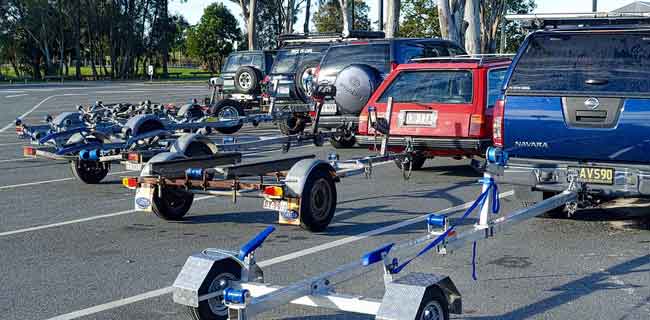Things that can go wrong with your boat trailer
Blog | October 22nd, 2022Things that can go wrong with your boat trailer

Trailer Lights
Commonly first or second on the list next to wheel bearings, trailer lights fail often due to the harsh environment they live in and, of course, lack of maintenance. Thanks to LED lighting, however, system problems have dropped dramatically.
Flickering: If all the lights flicker, this usually comes from an intermittent ground. If your trailer ground (white) wire is not connected, and you’re using the ball coupler as the ground, this is usually the result
No turn signal/brake light: Check the ground or the power wire for the problem light (green on the right side, yellow on the left). Again, if you have incandescent lights, remove the lens, and ensure the bulb is not damaged and is making its connection to its mounting base solidly.
No running lights: Check the ground or the power wire (brown) for the running lights. For incandescent lights—yes, you guessed it—see above.
Rollers
Rollers get deformed and won’t turn, and the shafts get rusty. Fortunately, rollers are easy to replace. What to do:
- Measure, especially shafts. They’re available in many sizes, and you’ll need to ensure they stick out far enough on each side of the roller to get the retainer caps on.
- Consider replacing with poly rollers instead of the black rubber ones. Poly is more expensive by far, but it’ll last longer and won’t mar your hull with black streaks.
- Don’t forget the bow roller/bow stop. This part takes a lot of abuse, so it should be replaced.
Jockey Wheel
For the most part, today’s jockey wheels are inexpensive, disposable items. You can buy a swiveling, galvanized jockey wheel for less than $30 at most discount stores. Trouble is, the price reflects the durability and longevity; if you’re not careful, you’ll be replacing that jack inside a couple of years. Here’s how to make yours last a bit longer:
• When you use it to move your boat around the driveway, lower the jack almost all the way down. Moving it with the leg extended (at its weakest point) will cause premature failure.
• Keep the pivot point, dolly wheel and crank handle/mechanism well-lubricated.
• Touch up rusty spots with cold galvanizing spray to keep corrosion to a minimum.
• When storing, don’t use the jack to support the trailer; this will cause the plastic wheel to eventually flatten. Instead, use another support, taking the weight of the trailer off the jack.
Trailer Brakes
Brake problems often stem from poor maintenance. Most boat trailers employ surge brakes. Here are some common issues.
Low or no fluid: If the surge-brake actuator reservoir is low or empty, you’ll need to fill it properly, then bleed the brakes again. If the seals are leaking, you’ll need to rebuild the actuator or buy a replacement.
Corroded or nonworking coupler actuator: Replace the actuator if the current one hasn’t been maintained.
Crimped or damaged brake lines: Find the problem and repair the line. (You’ll need to add fluid and bleed the system again.)
Corroded brake-actuator mechanisms: Do a complete system overhaul. Start with new brake assemblies for each wheel.
Worn brake shoes or worn brake pads: You may need to replace them and also replace the drums or rotors.
Wheel Bearings
Next to trailer lights, wheel bearings seem like the most often reported problem among trailer boaters. If you’re towing down the road and experience bearing failure, it’s often too late. If you catch it in time, you might be able to field-fix the issue, if you’ve planned ahead and carried parts and tools. (An extra hub complete with bearings and grease is a great savior.) Before a long trip, make it a habit—part of your pre-trip checklist—to check the bearings, and repack or replace them if necessary, before you head out.
To avoid the problem in the first place, take a short test ride. Check the hub temperature at every gas and rest stop; feel the hubs on the inside and out for excessive warmth. If a hub gets hot, pull over as far as possible, raise the problem wheel, and remove the wheel and tire. Removing the hub will show the bad bearing. If the axle isn’t damaged, you can dress the surface with crocus cloth (plumber’s sandpaper) and clean it with some gasoline. Install the replacement hub, greasing it fully, and reinstall the cap (or bearing protector). Then reinstall the wheel and tire, checking for smooth operation by rotating the assembly and checking for excessive rocking and/or wobble before lowering it to the ground again.
Winch
The winch, strap and hook can fail at the most inopportune time—usually when you’re retrieving your boat, with a line of boaters waiting to use the ramp. Like most of the other components, the winch fails due to neglect and misuse. Here are some tips to keep yours working:
- Keep the winch strap straight; don’t allow it to fold or crease, or flip over on itself when cranking.
- Keep the hook’s safety latch lubricated and working freely.
- Lubricate the gears, shafts and fasteners on the winch.
- Keep the winch’s handle nut tight; otherwise, it will loosen and round off the handle axle.
- Keep the winch’s attaching bolts tight to the trailer’s winch stand.
- Make sure the winch and bow stop are at the correct height for your boat’s bow eye. When winched up tight, the bow eye should end up just under the bow stop/roller.
If you are looking for a new boat trailer or need your currently trailer repaired, serviced or upgraded, visit us today.
14a Barry Avenue, Mortdale NSW 2223 Australia
Phone: (02) 9533 3652
Email: sales@salestrailers.com.au
